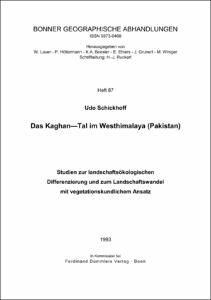Das Kaghan—Tal im Westhimalaya (Pakistan)Studien zur landschaftsökologischen Differenzierung und zum Landschaftswandel mit vegetationskundlichem Ansatz

Das Kaghan—Tal im Westhimalaya (Pakistan)
Studien zur landschaftsökologischen Differenzierung und zum Landschaftswandel mit vegetationskundlichem Ansatz

| dc.contributor.author | Schickhoff, Udo | |
| dc.date.accessioned | 2022-10-07T12:05:54Z | |
| dc.date.available | 2022-10-07T12:05:54Z | |
| dc.date.issued | 1993 | |
| dc.identifier.uri | https://hdl.handle.net/20.500.11811/10345 | |
| dc.description.abstract | In der vorliegenden Arbeit über das Kaghan-Tal im Westhimalaya (Pakistan) werden die dreidimensionale landschaftsökologische Differenzierung und der Kulturlandschaftswandel des Tales untersucht. Die Erfassung und die Analyse der Pflanzengesellschaften und ihrer Umweltbedingungen bilden die Grundlage dieser Untersuchungen. Das Tal ist in seinem Längsprofil von einem ausgeprägten Wandel von Klima, Böden und Vegetation gekennzeichnet und weist ein extremes Hochgebirgsrelief auf. Die Hochgebirgslandwirtschaft und die Forstwirtschaft haben entscheiden den Einfluß auf die Entwicklung der Kulturlandschaft. Zunächst werden die landschaftsökologischen Faktorenkomplexe behandelt, deren Zusammenwirken in der natürlichen Vegetationsverbreitung zum Ausdruck kommt. Im Anschluß daran erfolgt eine synökologische Charakterisierung der Pflanzengesellschaften. Sie umfaßt eine Interpretation der anthropo-zoogenen Beeinflussung. Abschließend werden die raum-zeitlichen Auswirkungen der sozio-ökonomischen Einflußfaktoren auf den Vegetations- und Landschaftswandel untersucht und die Interdependenzen zwischen Natur Raumausstattung und anthropogenen Nutzungsmustern aufgezeigt. | en |
| dc.description.abstract | The Kaghan Valley (Western Himalaya, Pakistan) - Studies on geoecological differentiation and landscape change
In the present study of the Kaghan Valley the three-dimensional geoecological differentiation and the changes of Vegetation and landscape are investigated. The analysis of the plant communities and their environmental factors forms the basis of these investigations. The valley is marked by a distinct change of climate, soils and Vegetation in its longitudinal section as well as by an extreme high mountain relief. Mountain agriculture and forestry are the crucial socio-economic factors determining the dynamics of the cultural landscape. The study Starts with the analysis of the complex of geoecological factors. The interaction of these factors is reflected in the natural distribution of the Vegetation. This analysis is followed by a detailed synecological characterization of the plant communities including the interpretation of the anthropo-zoogenic disturbances. Finally the socio-economic factors are investigated with regard to their spatial and temporal effects on the Vegetation and landscape change. The interdependencies between the natural environment and its resources and the pattems of land use are elaborated. | en |
| dc.format.extent | 285 | |
| dc.language.iso | deu | |
| dc.relation.ispartofseries | Bonner Geographische Abhandlungen ; 87 | |
| dc.rights | In Copyright | |
| dc.rights.uri | http://rightsstatements.org/vocab/InC/1.0/ | |
| dc.subject | Kaghan | |
| dc.subject | Landschaftsentwicklung | |
| dc.subject | Landschaftsökologie | |
| dc.subject | Vegetation | |
| dc.subject.ddc | 550 Geowissenschaften | |
| dc.subject.ddc | 910 Geografie, Reisen | |
| dc.title | Das Kaghan—Tal im Westhimalaya (Pakistan) | |
| dc.title.alternative | Studien zur landschaftsökologischen Differenzierung und zum Landschaftswandel mit vegetationskundlichem Ansatz | |
| dc.type | Dissertation oder Habilitation | |
| dc.publisher.name | Dümmler | |
| dc.publisher.location | Bonn | |
| dc.rights.accessRights | openAccess | |
| dc.relation.pissn | 0373-0468 | |
| dc.relation.pisbn | 3-427-76371-4 | |
| ulbbn.pubtype | Zweitveröffentlichung |




